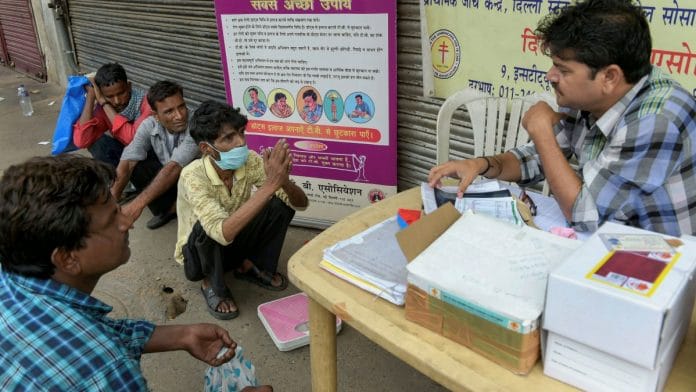As the world scrambles to find a definitive solution to the coronavirus pandemic, many experts think that adapting existing solutions – both systemic and scientific – to fight Covid-19 could help us find quicker ways to address the crisis.
And our fight against tuberculosis is what we need to turn to. There are many lessons India can take from its centuries-long fight to eliminate TB, which continues to kill thousands of people worldwide every year.
In India, dealing with our significant tuberculosis burden – 27 per cent of all the cases in the world – has taught us a thing or two about infection control. This is a lesson that could stand us in good stead as we gear up to deal with the deadly new coronavirus. For example, among the things critical to effectively tackling Covid-19 are accurate case identification, isolation and follow up and surveillance of those who might have been exposed to the virus.
Active case identification
The National Tuberculosis Elimination Program (NTEP) has focused on this for years now. In a country as vast as India, active case finding – the systematic identification of people with suspected active infection – is used in TB programmes to find what’s called the ‘missing million’ TB patients who go undetected and risk not only spreading the infection but also their lives.
Currently, the NTEP employs a large fleet of frontline health workers who go door-to-door in search of missing TB patients. However, this takes place only few times a year and isn’t an ongoing process. In Kolkata, a project by the United States Agency for International Development (USAID) adopted a unique approach to ACF by engaging health volunteers called Targeted Outreach for the Upliftment of Community Health (TOUCH) agents. They were part-time salaried community workers who were given incentives to find and follow up with TB patients and ensure treatment completion.
These initiatives can be adopted with appropriate changes/adaptations if the disease continues to spread for a long time or at least go through a second wave later this year as has been predicted by experts.
Also read: Five lessons the coronavirus pandemic can teach Indians
Treatment adherence
Many TB patients do not complete their treatment and, in doing so, run the risk of developing drug-resistance. Ensuring that the six-month course, which is often accompanied by major side-effects, is regularly adhered to is a significant challenge, especially in mobile populations or people living in remote, inaccessible areas. Many innovations have been developed to address this. Information and Communication Technology, or ICT, has lent itself well to the challenge of remotely ensuring that people follow up on their treatment regimen.
From a drug adherence perspective, Sensedose Technologies, an Indian healthcare start-up developed a device called Tuberculosis Monitoring Encouragement Adherence Drive (TMEAD). TMEAD leverages the power of physical alarm-based and digital notification-based reminders to make sure patients never forget their medicines. To avoid dosage errors, all the medicines prescribed are pre-sorted and pre-filled. Importantly, TMEAD application provides the functionality to track medical adherence patterns over a selected period.
ICT has also helped in developing quick screening tests for TB patients. For instance, Qure.Ai’s chest X-ray solution helps in the early identification of probable TB cases and helps doctors fast-track TB patients for confirmatory diagnosis.
Also read: Old drugs, new trials — hopes pinned on HIV, malaria, ebola, TB vaccines to fight Covid-19
Contact-tracing
Artificial Intelligence (AI) acts as a force multiplier for early and fast detection of tuberculosis. Through ICT, healthcare tools are becoming accurate, affordable, accessible and scalable.
Something that is quite consistent in TB diagnosis is contact tracing. Contact tracing is the process by which any person (contacts) one may have passed a serious infection on to is identified, diagnosed and then treated. This helps in stopping infections and diseases spreading further through the community. It has been critical in TB treatment and community-based approaches have been key to this effort. Contact-tracing would be critical in dealing with a virus like Covid-19.
There is a need for capacity building and providing safety equipment to community-based organisations to help in expanding contact-tracing across India.
Also read: 100-year-old TB vaccine now being tested for Covid-19, India may conduct a trial too
A better solution
Given that both TB and Covid-19 affect the lungs of its carriers, the use of AI can easily be adopted for initial screening of suspected Covid-19 patients, as is already being done in China, and build in an algorithm for tracking and following them up for better case identification and contact-tracing.
The world needs collaboration and TB is an example of this— stakeholders have come together to create a conducive environment, ensuring the highest level of political commitment in India.
We must apply this to all diseases including Covid-19 and learn from our experiences to find solutions to a safer, healthier and secure future.
The author is Executive Chairman of National Assessment and Accreditation Council (NAAC). A scientist and a Rhodes Scholar, he has contributed to the development of a recombinant vaccine for malaria. He received the Padma Shri award in 2012. Views are personal.






